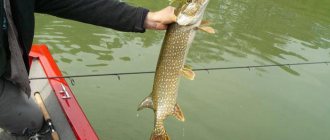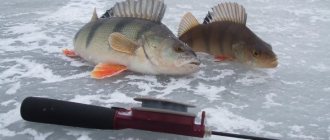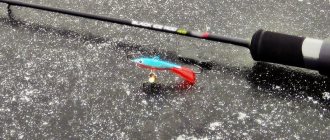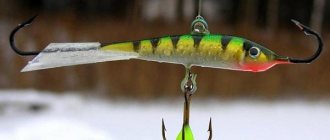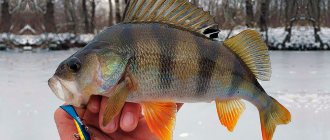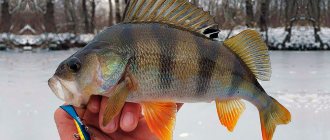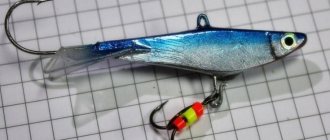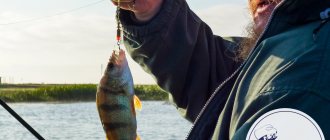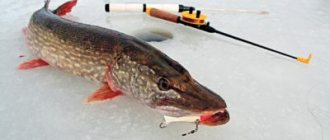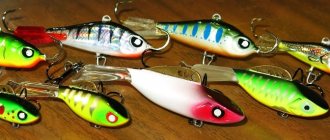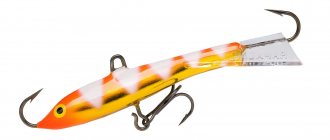Catching pike requires the fisherman to take into account a large number of subtleties and nuances. You need to know the habits of the predator, its favorite habitats, periods of activity, etc. It is especially important to choose gear - pike is quite selective and picky. However, if in the summer the fisherman has a fairly wide selection of baits - from twisters and wobblers to spinners of various designs - then in the winter balancers are out of competition. Properly selected, they produce good catches throughout the winter. Their behavior in the water resembles that of a wounded or weakened fry - and the pike cannot resist such a tempting and, at first glance, easy prey.
Balancer Dolphin, color 01 white/red ProfiLux 194 for 1 piece. Balancer Classic No. 7006 color 15 Helios 160 for 1 piece. Balancer NORDIC 40H Lucky John 238 for 1 pc. Balancer Classic No. 7006 color 44 Helios 160 for 1 piece. Balancer Master No. 7011 color 16 Helios 160 for 1 piece. Balancer 3203, color 146 Condor 158 for 1 piece. Balancer Snoop No. 7059 color 81 Helios 165 for 1 piece. Balancer Tulka 65 BLD065008BG PIRS 514 for 1 pc. Balancer, Blue Back Submarine 314 for 1 piece. Balancer Slasher No. 7040 color 9 Helios 165 for 1 piece. Balancer PIKE, color 118 AQUA 117 for 1 piece. Balancer PIKE, color 121 AQUA 117 for 1 piece. Balancer Usuri #7, RG Sprut 380 for 1 pc. Balancer 3201, color 161 Condor 158 for 1 piece.
Winter balancers for pike in assortment
At the same time, winter fishing for pike with a balance beam has many specific features and aspects. Firstly, you need to be able to choose a catchable bait. Secondly, you need to choose the right fishing tactics. Thirdly, you should choose the right place for fishing. Experts from the Trophy online store are ready to help you understand the theoretical part. And with the knowledge gained, you can begin to practice.
Balancer - what is it?
The balancer is a fairly heavy, full-bodied artificial fish designed for vertical vertical fishing. The fastening for the fishing line is located on the back of the bait approximately in the middle, so in the water it takes a horizontal position or with a slight rise in the bow. The balancer has two single hooks (front and back) and a hanging tee mounted under the belly. Thanks to the plastic “tail” in the shape of a curved blade, the bait has a unique game. During the throws, it “scours” around, imitating the movements of a live fish and thereby attracting a hungry predator.
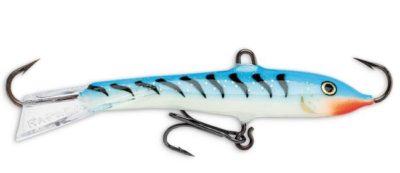
To successfully fish with balance beams, you need to correctly select all the elements of the tackle and master the basic technique of the game. When choosing the bait itself, the depth at the fishing site is first taken into account. A deep-water model will not be able to fully demonstrate its capabilities in shallow water, and vice versa, a lightweight balancer that works well in shallow water will not perform well in deep water.
What fishing line should I put on the balancer?
When catching a predator, it is recommended to use monofilament fishing line. It has a degree of stretch, which will avoid breaks during strong jerks. If the fishing depth does not exceed 5 m, then a fishing line of increased strength will be required. The most commonly used diameter is 0.22-0.25 mm, but the initial cross-section for winter fishing is 0.18 mm. An even smaller thickness will not give confidence in successfully fishing for fish; each bite can end in a break and loss of the balancer.
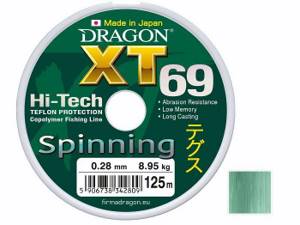
The packaging must be marked as “spinning” or “strong”. For example, when fishing, a pike begins to rush around, which often leads to rubbing against the edge of the hole. Here, some fishermen use a balancer line diameter even thicker than 0.25 mm, but such a move can lead to another negative consequence. The thing is that in winter, predatory fish become quite suspicious and can notice the fishing line in the water. In addition, greater thickness can greatly disrupt the play of the bait.
What gear to use
Effective fishing with balance beams is only possible with properly configured gear that matches the fishing depth and the weight of the baits used. Typically, anglers use fishing rods with a sensitive elastic rod. Too soft is not suitable for such a task; it will fail when swung. The rod is equipped with a small reel of inertial or inertia-free type. It is important to choose a reel so that it does not disturb the overall balance of the gear and does not introduce discomfort into the fishing process.
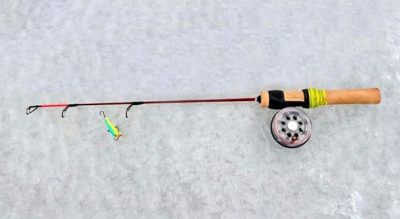
To fish for a large predator at a significant depth, you will need a more powerful rod with a petal at the end. To catch perch in shallow water, you can arm yourself with a light fishing rod equipped with a nod. Such gear is sold in any fishing store; alternatively, you can make it yourself from old summer spinning rods and feeder rods.
The equipment consists of a fishing line and accessories (fastener, swivel). The choice of fishing line color and diameter depends on the conditions on the reservoir and the expected size of the fishing object.
Balancer fishing technique
Fishing with a balance beam mainly consists of two stages - searching for predators and direct fishing.
First you need to decide on a suitable location. The choice depends on the specific reservoir and fishing period.
For the first ice, it is better to start from the coastal zone, as at this time most of the prey for predators lives there. In addition, being in the middle of a reservoir during this period is not always safe. In the dead of winter, fish go deeper, and the main fishing takes place away from the shore.
In any case, it is advisable for a beginner to start fishing near where other fishermen gather. This will save time searching. In addition, in this case, healthy competition will benefit everyone. The more baits are concentrated in a particular location, the greater the chance of attracting predators. The main thing is to maintain a reasonable distance to avoid snagging gear that produces a wide amplitude.
It is worth paying attention to the presence of frozen snags, bushes, changes in depth and small channels flowing into the reservoir. These objects allow the predator to swim unnoticed to its victims, which is why carnivores often live around them.
Having decided on the location, you need to move on to drilling holes. For effective fishing, you should make at least five holes (ideally ten). The distance between the holes is about 6 meters. Having drilled the last hole, it is advisable to give it a rest and start fishing from the first.
Before fishing, you need to pump all the wells one by one, spending no more than five minutes on each. However, if the bite begins during fishing, it is worth staying in this place longer. There have been cases when a fisherman caught most of his catch in the first half hour of exploration.
Main wiring
The process of swinging a hole involves performing the simplest wiring, which is suitable for most situations. Beginners can use it for basic fishing.
To perform this wiring you need:
- lower the load to the bottom;
- lift with a jerk by 15-30 cm;
- make a short pause (3-5 s), during which the bait sinks to the bottom;
- repeat the steps again.
How does the balancer play?
The basic technique of fishing with balance beams consists of tosses and pauses between them. In this case, the bait behaves as follows: during the throw it rushes to the side, and during the pause it takes its original position. Ideally, the balancer should go to the side as far as possible, turn around at the extreme point, come back and take the starting position with the nose forward.
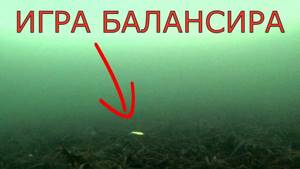
The intensity of the game can be different; the working amplitude of the throws and the duration of pauses are selected individually for each individual model. Sometimes sharp strokes of the fishing rod are effective, sometimes smooth ones. At first glance, this technique seems simple, but it has many nuances that can be learned with experience. For example, between casts you can make the bait “tremble” by gently twitching the tip of the rod. This technique works great for passive perch. In general, fishing with balance beams is a creative process; without experiments, you will not be able to fully master this bait.
Light tackle
A notorious winter spinner should have in his arsenal a lightweight fishing rod for balancers and light-weight spinners (up to 15 grams). This type of gear is the main one for winter fishing for perch at medium and shallow depths. With the fishing rod that we looked at at the beginning, fishing is done while standing, since the game requires wide-amplitude swings. Here we need a less amplitude game; it is more convenient to do it while sitting on a box and working with a brush. The fishing rod is miniature, the bite is transmitted to the hand.
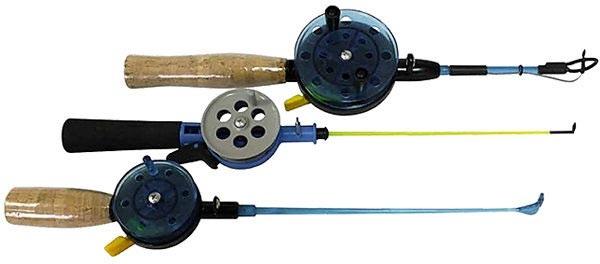
You can find a lot of such cheap lures on sale. They can be equipped with both reels and reels. At shallow depths, a fishing rod with reels is more practical. No time is wasted on winding and unwinding the fishing line, and during the transition the working part is wound onto one edge of the reel and the ring.

For perch fishing, it is better to equip the fishing rod with a nod. An inactive perch often slightly lifts the bait when biting, but on rough tackle this may not be noticeable. In this case, the nod is needed only to fix the rise. Therefore, a soft guard, popularly known as a “snot”, is best suited, since in the working position, under the weight of the balancer, it simply hangs down. In this position, any micro-lift of the perch will be clearly visible.
Whatever the configuration of the tackle, its sensitivity to the weight and play of the bait is important. Some anglers prefer the no-kick option. In a good fishing rod with a balancer, the whip should be very clearly matched to the weight of the bait - bend a little under it. For weakly active perch, it is more effective to use a nod-snot or nodless ultra-light tackle.
Kickless fishing rod for trolling
An ultra-light fishing rod for fishing with a balance beam in winter can be found in stores or made independently. Recently, homemade products from an ordinary balalaika have become popular. It is made very simply. The original whip is removed, a niche is drilled out for another tip from a carbon summer rod, longer and more elastic, up to 0.6 m. An even smaller hole is drilled in the niche, all the way through to the cavity of the reel. The fishing line in such a fishing rod runs inside the whip. Its tip can be equipped with a metal insert (so that the fishing line does not cut the cut end of the whip) or a soft silicone tube (based on the nod-snot principle). This type of gear has maximum sensitivity, so it significantly outperforms the others in terms of performance in the dead of winter for inactive perch. The sensitivity of such a rod allows you to use micro-spinners and even large jigs.
Winter glitter tactics
Fishing with a balance beam is not just twitching the bait under the hole. When going to a particular body of water, you need to clearly understand in what conditions and what kind of predator you will have to catch. In addition, you should take into account the depth at the fishing site, the strength of the current, illumination (time of day) and other factors on which the final result directly depends.
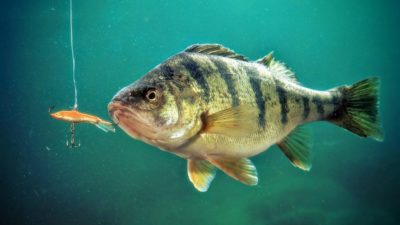
The only correct tactic when fishing with balance beams is an active and constant search. On narrow rivers and small lakes, the presence of fish at certain points can be determined by external landmarks. In vast areas of water you cannot do without such a useful device as an echo sounder. Even better is to use an ice camera.
You should know that immediately after freeze-up and on the last ice, fish can be found anywhere, almost anywhere in the reservoir. The predator is active at this time, often goes out to feed, and moves after schools of fry. In the middle of winter, during the so-called wilderness, the search area narrows significantly. In the midst of cold weather, there is no point in drilling holes wherever possible. To successfully catch a predator at this time, you need to at least know its winter camp sites. And you can interest him only by lowering the bait right under his nose.
Some winter fishermen go fishing at random, they say, we will catch what will be caught. This is fundamentally wrong; you need to clearly know your goal and purposefully seek it. Tactics are based on the type of fish you plan to catch. Accordingly, baits, in our case balancers, are selected for a specific fish. For those who have just begun to explore this fishing trend, we present a list of the most catchy baits for catching the main predators that live in our rivers and lakes.
Presence or absence of blades
Balancers do not necessarily have to have plastic blades, it can be a tail made of silicone or feathers. Very often, experienced fishermen divide balancers on this basis, since the game directly depends on whether they have blades. Tackles with blades are designed for more active retrieves than those without blades.
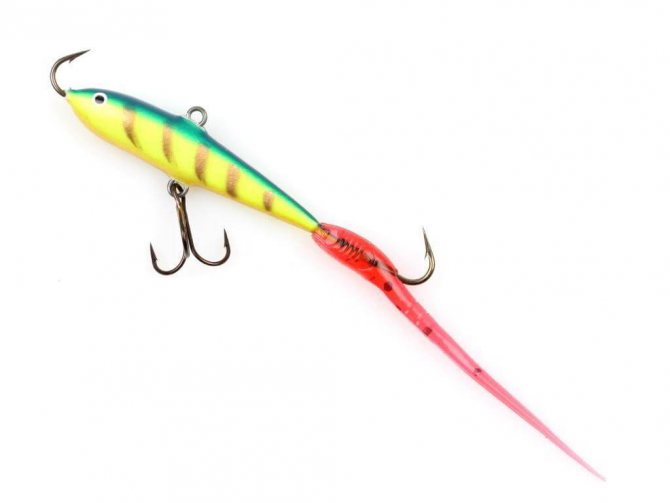
The plastic tail helps stabilize the ironfish in the water and smoothes out small errors in balancing. Gear without blades does not have such an assistant, so it must be perfectly balanced. Otherwise, the game will scare away the predator.
Most bladeless fish also have a tail, but it is made in the form of hair plumage. Its disadvantages include the inability to stabilize the load in case of weight imbalance and frequent frostbite at low temperatures. However, it gives the movements of a quality bladeless bait smoothness and naturalness.
Bladeless ironfish vary in weight, since the place and period of use of the gear depends on this parameter.
Tackle with blades
Weights with a plastic tail for additional stabilization are most common. Therefore, they have long been associated with the standard type of these baits. Most fishermen, when asked what a balancer looks like, describe blade models.
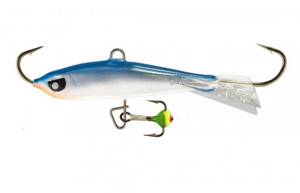
First of all, they are intended for aggressive play during periods of greatest predator activity. However, many high-quality models also work in the dead of winter, when the fish become more cautious and go to the bottom.
There are many types of wiring for bladed specimens. They vary depending on the purpose, from the most aggressive for coastal bass fishing to the slow and smooth ones for walleye fishing.
Although the tail smooths out minor imbalances, it is recommended to check your gear before fishing. A significant imbalance in weight can negatively affect the game and deprive the angler of bites. There are special specimens with a heavier front part, designed for vertical play near natural obstacles (coastal bushes, snags and tree branches).
Combined
Some models combine plastic blades and wool tails. They have their own unique game. The blades improve balance when moving parallel to the bottom, and the tail allows for smooth turns.
As a result, high-quality tackle produces fast eights even with a slight rise, which is good for attracting predators in early winter during periods of greatest activity.
Sets of high-quality combined balancers are quite rarely available in stores. Many fishermen make their own by adding blades to the hair tail (and vice versa). The main thing is to maintain the necessary proportions so that these elements do not interfere with each other when moving.
Lungs without blades
They are used at shallow depths (up to 3 meters) in the coastal zone. The size of the tackle varies from 3 to 6 cm, with a weight of up to 7 grams.

With proper weight distribution, these rigs best represent the movement of a wounded fry in shallow water. As a result, all passing predators peck at them. There is a chance of bites even in the middle of winter, when most of the fish go deeper.
The main maneuvers with this load are performed smoothly, with slight acceleration on the rise and a leisurely descent to the bottom. It is advisable to check the movements of the gear before the main fishing. A bathtub filled with water or a small pond is suitable for this.
Heavy bladeless
Light bladeless gear is not suitable for fishing at significant depths. To do this, you need a heavier load (weighing 7 grams or more). They are mainly used during the dead of winter, when most large fish live at the bottom of the reservoir.
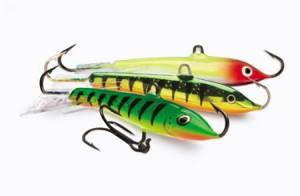
The wiring of heavy bladeless specimens is basically similar to that of light ones. They consist of smooth ascents and leisurely descents to the bottom, which alternate with fairly long pauses.
Fishing with heavy specimens requires more serious equipment (strong rod, thick fluorocarbon line, leader and reliable hooks). Otherwise, a large predator may break loose and leave with the bait in its teeth.
Silicone and plastic
There are also more non-standard varieties of this gear, made of plastic and silicone. They are designed for active fishing at depths of up to 3 meters.
Silicone specimens are practically not used at great depths, since they are not capable of showing realistic play under high pressure. In addition, large predators living on the bottom, such as pike, can easily ruin the soft material.
The wiring of silicone and plastic fish is in many ways similar to jigs - sharp, carried out at a small amplitude, with trembling and frequent tapping on the bottom.
The best balancers for winter fishing for perch
In winter, striped robbers become a popular target for anglers. They are caught on small balancers, the tee of which is decorated with beads or a tuft of bright wool. It is this provocative element that irritates the perch and forces it to attack. The following models are considered leaders in striped fishing:
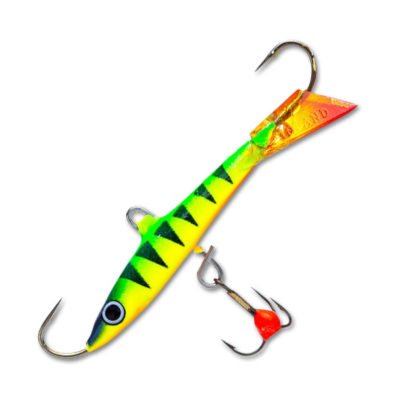
Karismax Koko is a high quality Finnish winter lure that ice fishing enthusiasts rate as one of the best in the world. The Coco 4 line is considered the most successful of all those produced by Karismax. The light models included in it work perfectly for small and medium-sized perch at a depth of up to 1.5 meters, and the heavy ones catch humpback whales in the bottom horizon in holes. Finnish experts have pleased us even more with the assortment of colors from which you can choose a catchable balancer for different weather conditions.- Lucky John Pliant is a well-balanced artificial fish with realistic coloring. If the target is perch, you should not get carried away by the large size of the bait (more than 5 cm), since it is also interesting to pike and pike perch. Pliant from Lucky John is made according to a classic design, equipped with a semi-rigid tail and high-quality Japanese Owner hooks. The manufacturer offers 14 different colors and 4 sizes of this bait for catching various predators, but fishermen unanimously declare that it is most suitable for “swinging” perch holes.
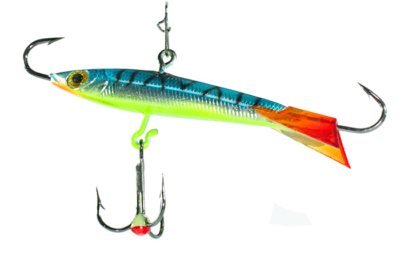
Nordway Iceangrep are classic balancers for ice fishing, characterized by a flexible body, realistic play, high-quality assembly and an affordable price. The line includes different sizes, including many perch ones - up to 5 cm. The choice of colors is wide, but the palette is dominated by natural colors. This bait performs best when catching striped fish at shallow depths in snags.- Strike Pro Challenger Ice is a product from a Korean company that can adequately compete with branded European models. Challenger Ice balancers are easily recognizable among today's variety of lures in this category due to their slightly protruding belly (closer to the front). This affects the nature of their play, and I must say, it has a positive effect. There are no complaints about the assembly, coating, quality of hooks and plastic tail.
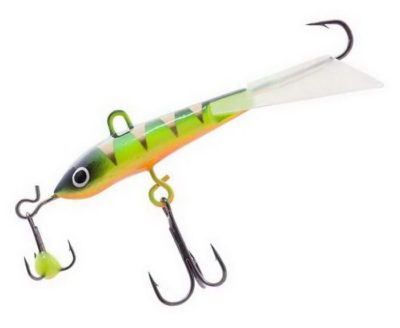
Select Jack is one of the best baits for fishing active perch from the ice. This fish is distinguished by its elongated tail, which allows it to make stretched “figure eights” under water. Her game is noticeable from a great distance and the striped robbers are the first to approach her. The balancer is intended for use at medium depths and insignificant currents. Under these conditions, it can be used to “swing” the hole in just a few minutes.
Balancers for winter fishing for pike perch
The rating of the most effective pike perch models is based on numerous positive reviews from fans of catching predatory fish from ice. They note that you can seduce a fanged one with different baits of this type, but it is the five listed below that almost always work flawlessly:
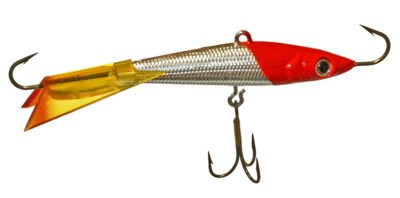
Scorana Ice Crystal Mark 2 is a very catchy balancer with expressive eyes and bright provocative coloring. His appearance, combined with his measured game, causes the predator to have an irresistible desire to attack. The manufacturer included 4 standard sizes in the line from 4 to 8 cm. The weight range is 8-32 g. This is enough to select a bait for different conditions, in particular the depth and strength of the current.- Cooper - balancers from a Perm company, among which there are also “pike-perch” versions with phosphorus coating. These are quite heavy models N-7, V-7 and Golyan, designed for deep fishing for trophy pike perch. They catch properly, and they cost mere pennies compared to branded products.
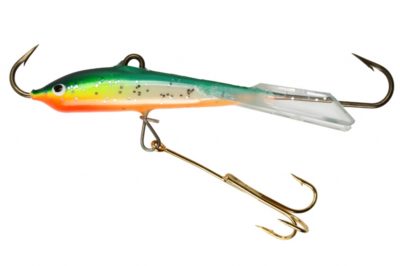
Nils Master Jigger – metal winter lures with a plastic shell, equipped with long tees at the bottom. They are painted to look like a perch, are ideally balanced, have a specific game - when thrown, they sharply move to the side, smoothly turn around and quickly return to their original position. Just what the fanged one likes. The model range consists of 4 baits ranging from 5 to 12 cm in length and weighing from 8 to 45 g.- Rapala SNR - balancers with a unique geometry in which the backrest meets the wing. They play smoothly, but sweepingly, with a large amplitude, strongly deviating from the vertical axis. They seduce not only predators in close proximity, but also from a distance. For ice fishing, especially during the deep winter, when the fish are passive, this is a very important quality.
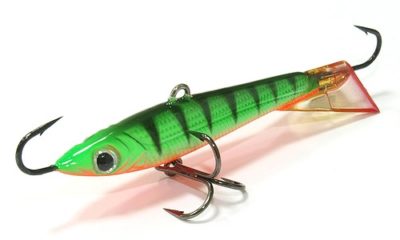
River 2 Sea Pliant is a great offer from the Australians. River 2 balancers are manufactured with the highest precision, therefore they have stable, high-quality play. The realism of the bait is added by voluminous eyes and a 3D body coated with a double layer of varnish. The “tenacious” Japanese Daiichi hooks deserve special praise. Once on one of them, the predator has little chance of freeing itself.
To make the balancer even more attractive, many anglers tie a tail in the form of a tuft of hair to the wing. This additional stimulus helps to “stir up” the passive pike perch.
Pike balancers for winter fishing
When going to catch a toothy beast on a frozen body of water, it is advisable to have several balancers of different sizes and colors in your arsenal in order to be able to select the catchable one experimentally. For an experienced angler this is a simple task, but for beginners the list below will help:
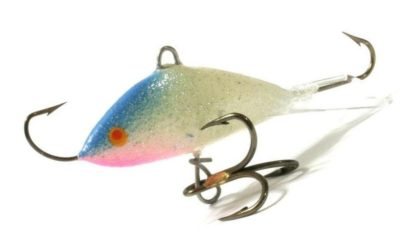
Nils Master Baby Shad is a “fat fish” that can interest a pike with its sweeping game. During the swing, it rushes upward, creating attractive vibrations, reaches a certain point and moves away to the side. At first glance, this behavior of an artificial fish can only attract an active predator, that is, it will be effective on the first and last ice, but practice has shown that Baby Shad works well even in the depths of winter.- Aqua Trapper - balancers in sizes 56 and 72 mm, which are excellent for catching pike at small and medium depths, where the predator often prowls in search of fry. They have a light-reflecting holographic coating that is visible from a great distance. They are equipped with reliable, sharp hooks, thanks to which there are practically no annoying slips.

Lucky John Mebaru are short-bodied heavy baits with an equally short plastic tail. The sufficiently large weight allows them to be used at depth and in strong currents, where there is every chance of catching a trophy pike. The balancers of this series are equipped with a brass “fin” with holes for fishing line, thanks to which the angler has the opportunity to change their game. For example, if you fix the fishing line in the middle hole, the fish plays in a sweeping manner and goes far from the hole during the throws.- Jarmo Jarmor Hopeakala is a line of catchy winter lures from Finnish specialists who have accumulated considerable experience in fishing. All models were developed jointly with representatives of Rapala. As a result, we managed to obtain excellent balancers that produce stable “figure eights” on the wiring with minor fluctuations. They have an incredible ability to catch pike, especially on those days when the toothy one is actively feeding.
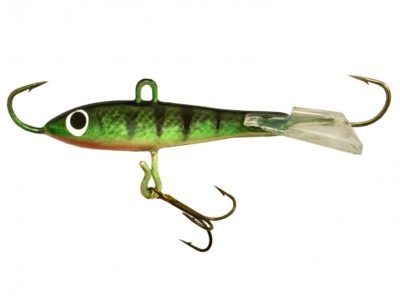
Frost Nova are budget balancers that you don’t mind tearing off. When searching for a predator, they can be used as scouts. But this is not a reason to doubt their effectiveness; it is quite high. Actually, so is the quality of workmanship. There are even models with phosphorus coating for winter fishing at great depths. Large lures with a length of at least 5 cm are suitable for pike fishing. Anglers who cannot afford expensive branded products opt for Frost Nova balancers.
Selection by external characteristics
In addition to the presence of blades, these baits are also divided according to a number of characteristics, such as color, shape and size. This mainly applies to the lobed species, since they are more common.
When choosing gear with a certain characteristic, you need to consider how it affects the effectiveness of fishing in a particular situation.
Size and weight
The length of the balancer is always proportional to the size of the expected prey. For small predators, such as perch, baits up to 6 cm are intended. In the case of catching pike or pike perch, a length of 7 cm is required.
When choosing a weight, it is necessary to take into account the depth of the reservoir. Below is an approximate ratio:
- reservoir depth up to 3 meters - load weight up to 3 g;
- 3-5 meters - up to 6 g;
- 5-7 meters - from 5 to 8 g;
- from 8 meters - from 9 g and more.
These indicators are very conditional. The choice of the required weight can also be influenced by the strength of the current, soil composition, temperature and water transparency.
Some anglers believe that paddle balancers of any weight are ineffective in depths greater than 8 meters. However, there are now a number of models with plastic blades specifically designed for deep sea fishing.
Form
This aspect determines the movement of the load in the water and the overall course of the game.
Classic iron fish with narrow noses and evenly distributed weight are used in large spaces. They describe wide figure eights, producing sweeping vibrations. In cold, clear water, these baits are able to attract predators at a maximum distance.
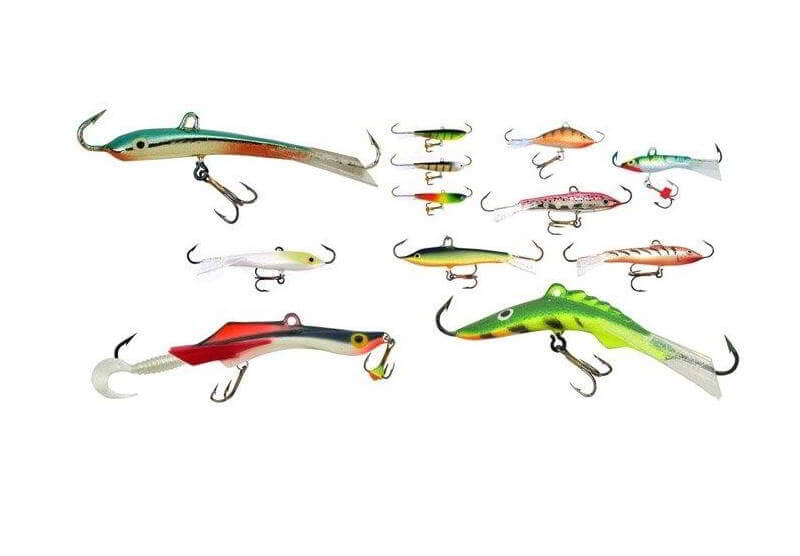
Fish with a larger head and weight shifted to the front are used for aggressive vertical retrieves. They can be used in the coastal zone, near snags and frozen bushes. They are indispensable where the classic sweeping game carries a high risk of getting caught on foreign objects.
Curved fish are also used for vertical play, but unlike large-headed fish, they sink to the bottom faster. Sometimes the prey bites precisely after such movements.
Heavy humpback baits are used mainly at great depths. Their main targets are large pike perch and pike that have sunk to the bottom. They are characterized by leisurely movements with smooth swaying and long pauses between movements.
Color
Many fishermen debate whether color affects bites. There is an opinion that various colors are created only to attract buyers.
Many anglers prefer certain colors, believing that predators are more likely to bite on them. This is confirmed by statistics from various competitions.
For example, during the day in some reservoirs, silver colors are more effective, as they play well in the light. And at night, at depth, it is better to use brighter acidic shades.
The optimal solution, suitable for various conditions, is considered to be a color that imitates the natural color of the main prey of a predator. These can be gray-silver colors with elements of red (imitation of a roach), dark stripes (like a perch fry) or a greenish-gray color (the color of a crucian carp).
Color is not a determining factor in successful fishing. And yet this element is important, as it complements the overall image of the bait, making it more natural in the eyes of a predator.
Hooks and tee
When choosing gear, you need to pay attention to the steel from which the hooks are made. Poor quality samples may bend or break even with light pressure. If the hooks are not sharp enough, you can sharpen them at home.
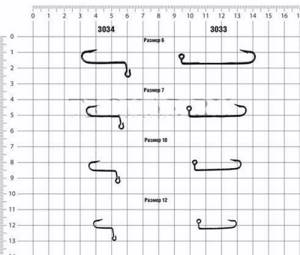
Mostly predators cling to the tee. Therefore, you need to pay special attention to this element. The harness should not fit closely to the belly. Otherwise, the fish simply won’t be able to take it. To increase the distance, small transition connections are used, like a simple carabiner.
You can decorate the tee with beads or bright multi-colored cambrics. In low light conditions, pendants equipped with special phosphor elements are used.
How to make a balancer for winter fishing with your own hands
Most often, craftsmen make fish for ice fishing in the simplest way - casting. First, two plaster molds are prepared. While the plaster, diluted to the point of sour cream, has not hardened, a store-bought model is applied to it so that it fits in exactly halfway. First, the tee and plastic tail are removed from it, and the body is lubricated with grease.
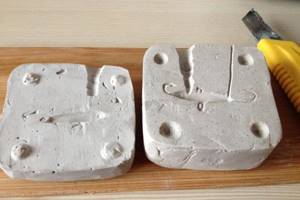
The dried molds are ground and grooves are cut into them, which, when connecting the two halves, act as a casting hole.
The casting process itself consists of several stages:
- the molds are warmed up;
- hooks and loops twisted from wire are laid;
- both forms are connected;
- Molten lead is poured through the casting hole.
When the lead fish hardens, it can be removed, processed with a file, painted and varnished. The tail is usually made from a plastic bottle. It can be glued with waterproof superglue and, for greater reliability, the joint can be coated with epoxy resin.
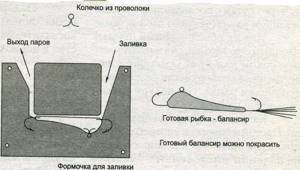
Balancers are not cheap, so many ice fishing enthusiasts prefer to make them themselves. Some have become real masters in this matter; in terms of build quality and performance, their baits are not inferior to expensive branded models.
Video on the topic:
Review of balancers for winter fishing - Accurat.
13:06
Top 10 best balancers for catching pike and other predatory fish (perch, pike perch, bersh)
06:37
LIVING BALANCER DIY Winter fishing
12:09
MANUFACTURING A BALANCER / WITH YOUR HANDS / homemade /
09:23
narybalke

